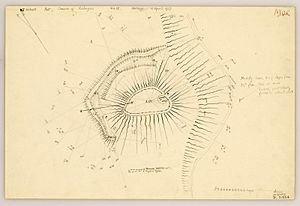Doune of Relugas facts for kids
 |
|
| Coordinates | 57°31′31″N 3°39′56″W / 57.5253°N 3.6655°W |
|---|---|
| Type | Hill fort |
| Length | 53 metres (174 ft) |
| Width | 33 metres (108 ft) |
| Height | 400 feet (120 m) AOD |
| History | |
| Material | Stone, earth |
| Periods | Iron Age, Pictish |
The Doune of Relugas is an ancient hill fort found in Moray, Scotland. It sits on a rocky hill about 9.25 kilometres (5.75 mi) south of Forres. This special spot is where the River Findhorn and the River Divie meet. From here, people could see far across the Findhorn valley, all the way to Culbin Sands near the Moray Firth.
Contents
Discovering Doune of Relugas
This hill fort was used for a very long time. People lived here from the Iron Age (around 1000 BC to 1 AD) through to the Pictish times (from 1 AD to about 1000 AD). It was an important place for many centuries.
What is a Hill Fort?
A hill fort is a type of fort built on a hill. These forts were often surrounded by strong walls or ditches. They provided a safe place for people to live and protect themselves. Many hill forts were built during the Iron Age.
Inside the Fort
At the heart of the Doune of Relugas was a strong wall called a "timber-laced rampart." This wall was made of wood and earth, making it very tough. It enclosed an oval-shaped area about 53 metres (174 ft) long and 33 metres (108 ft) wide. There was a gap on the east side, which was probably the main entrance.
Even though the fort was naturally protected on the east and south by the steep hills, there were more defenses. To the north and west, there was an outer ditch and an earthen wall. The ditch was about 5.5 metres (18 ft) wide and 2.0 metres (6.6 ft) deep. Behind it, the wall rose about 1.5 metres (4.9 ft) high.
The Mystery of the Burned Stones
Some of the stones from the fort's walls show signs of "vitrification." This is a process where stones get so hot that they melt and fuse together, like glass. This suggests that the fort was burned down at some point in its history. It might have been attacked or destroyed by fire. Other nearby forts, like Dun Evan, Dun Finlay, and Dun Davie, also show signs of vitrification.
A Fort in a Garden
Much later, in the 1800s, the remains of the Doune of Relugas became part of a beautiful garden. A writer and expert in old things named Thomas Dick Lauder included the fort's ruins in the design of the Relugas estate. He made it a feature of the "picturesque" landscape, which means it was designed to look like a beautiful painting.


